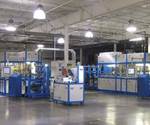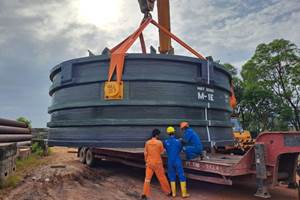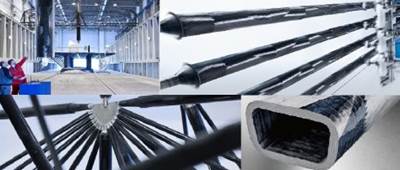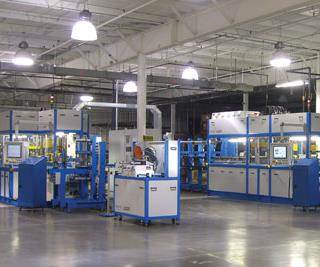CFRP adapters deliver high-quality printing at lower cost
Filament wound, carbon fiber/epoxy cylinders meet customer performance demands.
Flexographic (flexo) printing uses flexible rubber or plastic printing plates with slightly raised images to transfer ink at high speed onto a wide range of substrates. Commonly used to print plastic bags, giftwrap, milk cartons and candy bar wrappers, flexo is expanding, drawing printers away from gravure and offset methods. Flexo printing uses thin sleeves — made from polymer, fiberglass, carbon fiber or a mixture — which are installed over a steel or carbon fiber-reinforced polymer (CFRP) mandrel with drilled holes that allow compressed air to stretch the sleeve, enabling the press operator to “float” it onto the mandrel. Then the air is shut off, and the sleeve shrinks tight.
FlexoTech Magazine’s August 2014 article titled, “If the sleeve fits,” noted a trend toward thinner sleeves, CFRP sleeves and adapters. The latter, lightweight cylinders used between the mandrel and the outer print sleeve, also require air-cushion installation. Adapters bridge large differences in the print-sleeve circumference, enabling printers to reduce the number of differently sized printing cylinders required. Noting this trend, INOMETA (Herford, Germany) has developed the INOflex pneumatic carbon bridge adapter, which enables the use of lower-cost clamping systems while maintaining high print quality and speed. “Hydraulic clamping systems typically require a high investment cost that is only feasible for very high print runs,” says INOMETA head of development Christian Göhner. Pneumatic clamping systems work like the typical sleeve installation described above, but hydraulic systems use steel sleeves on both mandrel ends which expand under oil pressure. Göhner says the latter offers “a perfectly rigid mounted adapter and gives much better print results compared to the elastic assembly of the pneumatic system.” INOMETA’s INOflex adapter enables printers to use lower-cost pneumatic systems yet stay competitive via small print runs, short set-ups and flexible response times and deliver print quality on par with hydraulic systems. INOMETA supplies pneumatic and hydraulic adapters, which Göhner says are similar in cost, yet the price of hydraulic clamping systems purchased elsewhere can be two to five times that of air-based alternatives.
The INOflex CFRP pneumatic bridge adapters also feature an integrated seal, which improves installation, and an integrated damping system for vibration reduction, which can be tailored to customer requirements. Meanwhile, the INOflex CFRP hydraulic bridge adapters are up to 80% lighter than aluminum for 80% less moment of inertia, easy handling and quick installation, and offer up to 25% more bending stiffness, adjustable vibration damping (up to 20 times that of steel) and excellent print quality at speeds of 200-600m/min and faster. They are filament wound with a range of fiber inputs, from high-modulus to ultra-high-modulus carbon fiber, and epoxy resin, all chosen to match customer requirements for deflection, critical speed, damping and cost.
“Our main target is to minimize the deformation of the adapter under nip-load because this greatly influences the printing result,” explains Göhner. This deformation is caused by a combination of bending, shear deflection and flattening. “Filament winding gives us the ability to tailor stiffness in the axial, hoop and shear directions to create the perfect combination for the loads seen in flexographic printing.” INOMETA also uses finite element analysis and in-house-developed engineering calculation programs to quantify flattening and, thus, facilitate selection of the materials and fiber orientations to resist it. Of course, INOMETA must then be able to actualize its designs. “We have developed very advanced and automated filament winding technologies,” claims Göhner, “and maintain very tight tolerances during our CFRP tube manufacturing.” INOMETA also has access to a wide array of composites processes through its sister companies Xelis and Dynexa, as a member of the Herford, Germany-based AVANCO Group (see endnotes).
Read more about Xperion, now Xelis in Aerospace-grade compression molding and about INOMETA’s parent company in AVANCO: Driving the industrialization of CFRP structures as well as sister company Dynexa in Composite output shaft ready for automotive proving ground .
Related Content
Composites end markets: Infrastructure and construction (2024)
Composites are increasingly used in applications like building facades, bridges, utility poles, wastewater treatment pipes, repair solutions and more.
Read MoreNorco GFRP molds meet high-quality cast concrete beam production needs
A project with P&M successfully achieved manufacture of six 20-meter-long architectural beams for an R&D facility with near-seamless surfaces and on a tight production schedule.
Read MoreCirculinQ: Glass fiber, recycled plastic turn paving into climate solutions
Durable, modular paving system from recycled composite filters, collects, infiltrates stormwater to reduce flooding and recharge local aquifers.
Read MoreMighty Buildings opens new factory in Monterrey, Mexico
Company takes next step in strategy to scale rapid development and construction of 3D-printed, climate-resilient, carbon-neutral homes leveraged by patented composite materials.
Read MoreRead Next
AVANCO: Driving the industrialization of CFRP structures
The AVANCO Group is producing high-quality CFRP parts into a wide array of applications from six production facilities in Germany and the US.
Read MoreAerospace-grade compression molding
Continuous Compression Molding process produces structures 30 percent lighter than aluminum at costs that have both Airbus and Boeing sold.
Read More“Structured air” TPS safeguards composite structures
Powered by an 85% air/15% pure polyimide aerogel, Blueshift’s novel material system protects structures during transient thermal events from -200°C to beyond 2400°C for rockets, battery boxes and more.
Read More






















